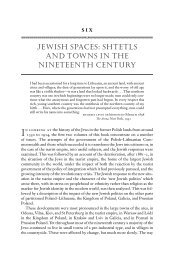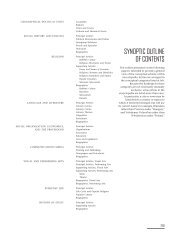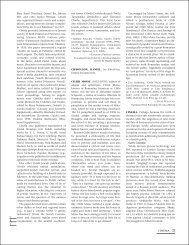t any plant names in Yiddish - YIVO Institute for Jewish Research
t any plant names in Yiddish - YIVO Institute for Jewish Research
t any plant names in Yiddish - YIVO Institute for Jewish Research
Create successful ePaper yourself
Turn your PDF publications into a flip-book with our unique Google optimized e-Paper software.
XVI<br />
˘È„”È Ôȇ ËÏÚÂÂ≠ÔÒ˜ÈÂÂÚ‚ È„ Ÿ ¯ÚËÎÚ˘ È΄¯Ó<br />
<strong>in</strong> turn is a loan translation <strong>for</strong> the name of Raphanus sativus radicula,<br />
named 'lunar radish' <strong>in</strong> a number of European languages<br />
(Polish, Ukra<strong>in</strong>ian, Rumanian, etc.). The first step – from 'lunar<br />
radish' to khóydesh-rétekhlekh – is simple: calqu<strong>in</strong>g. The next<br />
step, however – reshkhóydesh-rétekhlekh – is a humorous further<br />
development.<br />
3. A word with m<strong>any</strong> synonyms <strong>in</strong> <strong>Yiddish</strong> ethnobotanical term<strong>in</strong>ology<br />
is 'p<strong>in</strong>e cone'; shíshke (with its northern variants síske, síshke, shíske),<br />
shíshnik, shlóf-bérele, shlófepl, shlófépele, the last two variants<br />
appear<strong>in</strong>g <strong>in</strong> the writ<strong>in</strong>gs of Y.-M. Lifshits and Y.-L. Perets. Here<br />
aga<strong>in</strong> we f<strong>in</strong>d a branch<strong>in</strong>g-out that possibly <strong>in</strong>cludes a humorous<br />
<strong>for</strong>mation. Shlóf-bérele 'sleep berry' and shlóf-épele (pronounced<br />
/shlufepele/) 'sleep apple' are calques from a number of Slavic languages,<br />
where the term 'sleep berry/sleep apple' is based on the<br />
belief that putt<strong>in</strong>g a p<strong>in</strong>e cone under one's pillow would <strong>in</strong>duce sleep.<br />
The co<strong>in</strong>age shlúfképele (<strong>for</strong> example <strong>in</strong> the works of Elyezer<br />
Shteynbarg) and shlúfképl (<strong>in</strong> the works of Y. Metsker and Y. Hesheles)<br />
is folk-etymology pure and simple. The next stage of development,<br />
shrúf-képele 'bolt head', with shluf 'sleep' re<strong>in</strong>terpreted as /shruf/,<br />
SEY <strong>for</strong> shroyf 'bolt' (screw), is either spontaneous folk-etymology<br />
or a tongue-<strong>in</strong>-cheek remodel<strong>in</strong>g of a word which <strong>in</strong> its previous<br />
stage was clearly understood as a sleep<strong>in</strong>g aid. The break<strong>in</strong>g of<br />
the etymological tie could have been the result of playfulness. At<br />
<strong>any</strong> rate, while shlófépele/shlúfépele is 'only' a calque, shlófképl,<br />
shlófképele, shrúf-képele are all <strong>in</strong>ternal <strong>Yiddish</strong> developments.<br />
4. A question that is often raised is, where does kúres-bárlekh come<br />
from? This term is a l<strong>in</strong>k <strong>in</strong> the evolutionary cha<strong>in</strong> beys-hakvóres<br />
>beysakvúres >beysakúres >kúres, with the elim<strong>in</strong>ation of the /v/<br />
<strong>in</strong> postconsonantal position <strong>in</strong> some words <strong>in</strong> a large area of Southern<br />
<strong>Yiddish</strong> (<strong>for</strong> example, tsvíshn >tsíshn, tsvúgn >tsúgn, kvurt >kurt)<br />
(Mieses 1924: 66). In other words, kúres-bárlekh stems from beyshakvóres-bárlekh<br />
– pears grow<strong>in</strong>g <strong>in</strong> the cemetery, that is, wild<br />
pears, a synonym <strong>for</strong> váldbarlekh, vílde bárlekh, dz(h)í(tsh)ke bárlekh,<br />
dz(h)í(tsh)kelekh, etc.<br />
Plant <strong>names</strong> <strong>in</strong> idioms, proverbs, and similes<br />
M<strong>any</strong> <strong>Yiddish</strong> <strong>plant</strong> <strong>names</strong> have become part-and-parcel of <strong>Yiddish</strong><br />
idioms, proverbs, popular similes: kebébe mit lákrits, hándlen mit kébebe<br />
(kubébe/kebébe/kabébe be<strong>in</strong>g the <strong>Yiddish</strong> term <strong>for</strong> Piper cubeba; lákrits,<br />
the cognate of the English licorice – the term <strong>for</strong> Glycyrrhiza); farfáln vern<br />
vu der shvártser féfer vakst 'to disappear without a trace' (shvártser féfer –<br />
the <strong>Yiddish</strong> term <strong>for</strong> Piper nigrum); shtark vi a demb 'strong as an oak',<br />
hóy(e)kh vi a sósne/topólye 'tall as a p<strong>in</strong>e/poplar', a noz vi a barbúlkele ' a
















